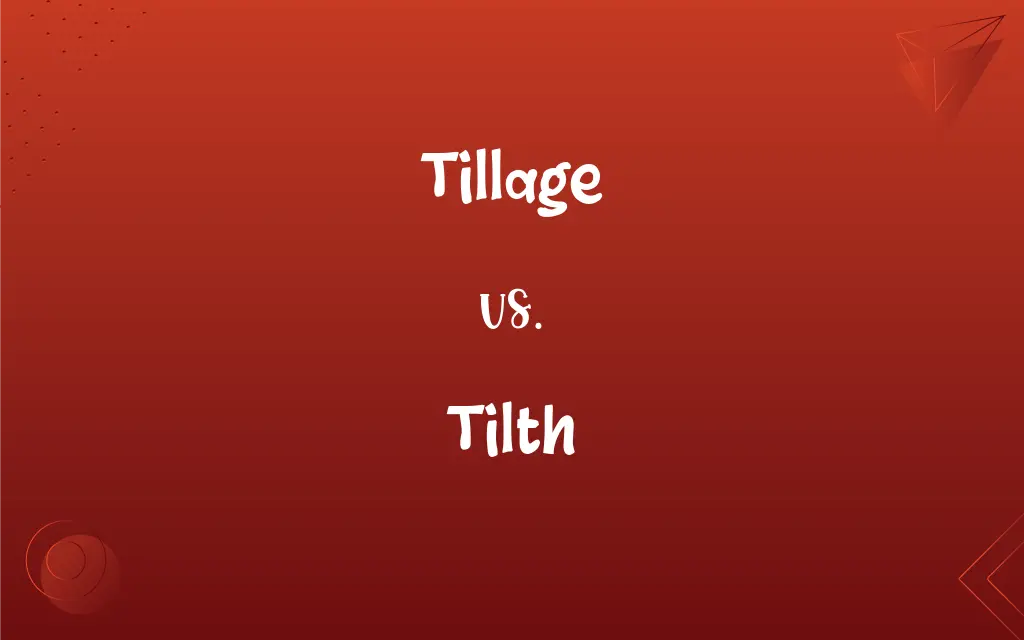Tillage vs. Tilth: What's the Difference?
By Harlon Moss & Janet White || Updated on May 20, 2024
Tillage refers to the agricultural process of preparing the soil for planting through mechanical agitation, while tilth describes the physical condition and health of the soil, particularly its suitability for growing crops.

Key Differences
Tillage is the agricultural practice of preparing the soil for planting by mechanically agitating it. This includes plowing, harrowing, and turning the soil to aerate it, incorporate organic matter, and control weeds. Tilth, on the other hand, refers to the physical condition of the soil, specifically its structure, texture, and fertility. Good tilth means the soil is well-aerated, retains moisture effectively, and has an optimal balance of nutrients, making it ideal for plant growth.
Tillage focuses on the active process of soil preparation, involving various mechanical techniques to improve soil conditions temporarily. In contrast, tilth is a more holistic term that describes the overall health and long-term condition of the soil, essential for sustainable agriculture.
Excessive tillage can negatively impact tilth by breaking down soil structure and reducing organic matter. Thus, maintaining good tilth often requires balancing tillage with conservation practices such as cover cropping and reduced tillage methods.
Comparison Chart
Definition
Agricultural process of soil preparation
Physical condition and health of the soil
Focus
Mechanical soil agitation
Soil structure, texture, and fertility
ADVERTISEMENT
Purpose
Create a seedbed, control weeds, incorporate organic matter
Promote optimal plant growth
Methods
Plowing, harrowing, turning
Influenced by natural processes and practices
Impact
Can cause erosion if excessive
Essential for sustainable agriculture
Tillage and Tilth Definitions
Tillage
The process of preparing soil for planting.
Farmers use tillage to prepare the fields for sowing seeds.
Tilth
The condition of the soil's structure and texture.
Good tilth means the soil is loose and crumbly.
ADVERTISEMENT
Tillage
Mechanical agitation of the soil.
The farmer performed tillage using a tractor and plow.
Tilth
Suitability of soil for growing crops.
The field's tilth was perfect for planting vegetables.
Tillage
Preparing a favorable seedbed for crops.
Proper tillage ensures better seed germination.
Tilth
The balance of nutrients in the soil.
Organic farming practices enhance soil tilth.
Tillage
Techniques to aerate and improve soil.
Tillage helps to mix organic matter into the soil.
Tilth
Cultivation of land; tillage.
Tillage
Soil disturbance methods like plowing and harrowing.
Effective tillage is crucial for controlling weeds.
Tilth
Tilled earth.
Tillage
The cultivation of arable land by plowing, sowing and raising crops.
Tilth
The fitness of soil for cultivation, as measured by its structure and composition.
Tillage
Cultivation of land.
Tilth
Agricultural labour; husbandry.
Tillage
Land that has been tilled.
Tilth
The state of being tilled, or prepared for a crop; culture.
The land is in good tilth and ready to plant.
Tillage
Land cultivated in this way.
Tilth
Rich cultivated soil.
Tillage
The operation, practice, or art of tilling or preparing land for seed, and keeping the ground in a proper state for the growth of crops.
Tilth
The state of being tilled, or prepared for a crop; culture; as, land is good tilth.
The tilth and rank fertility of its golden youth.
Tillage
A place tilled or cultivated; cultivated land.
Tilth
That which is tilled; tillage ground.
And so by tilth and grange . . . We gained the mother city.
Tillage
Arable land that is worked by plowing and sowing and raising crops
Tilth
The state of aggregation of soil and its condition for supporting plant growth
Tillage
The cultivation of soil for raising crops
Tilth
Arable land that is worked by plowing and sowing and raising crops
Tilth
Soil health, including aeration and moisture retention.
Farmers aim to improve tilth for better crop yields.
Tilth
Overall soil fertility and quality.
Maintaining tilth is vital for sustainable agriculture.
FAQs
What is tillage?
Tillage is the agricultural practice of preparing the soil for planting through mechanical agitation.
Can excessive tillage harm the soil?
Yes, excessive tillage can lead to soil erosion, degradation, and loss of organic matter.
Can tillage be minimized?
Yes, through methods like reduced tillage and conservation agriculture.
How does tillage affect tilth?
Tillage can temporarily improve soil conditions but may harm tilth over time if done excessively.
Why is tillage important?
Tillage is important for creating a favorable seedbed, incorporating organic matter, and controlling weeds.
Why is tilth important?
Tilth is crucial for ensuring the soil's suitability for plant growth, promoting better aeration, moisture retention, and nutrient balance.
Can good tilth be achieved without tillage?
Yes, through practices like cover cropping, organic amendments, and no-till farming.
What is tilth?
Tilth refers to the physical condition and health of the soil, particularly its structure, texture, and fertility.
What practices improve tilth?
Practices such as reduced tillage, cover cropping, and adding organic matter improve tilth.
Can tillage improve drainage?
Tillage can temporarily improve drainage by loosening compacted soil.
Why is soil aeration important?
Soil aeration is important for root growth and microbial activity, contributing to better tilth.
Is tillage always necessary?
Not always; conservation tillage or no-till farming can sometimes be more beneficial for soil health.
How is tilth measured?
Tilth can be assessed by examining soil structure, texture, moisture retention, and fertility.
What is the relationship between tillage and soil erosion?
Excessive tillage can increase soil erosion by disrupting soil structure.
What tools are used for tillage?
Common tools include plows, harrows, and cultivators.
What is no-till farming?
No-till farming is a method of growing crops without disturbing the soil through tillage.
How does crop rotation affect tilth?
Crop rotation improves tilth by preventing soil nutrient depletion and reducing pest buildup.
What is conservation tillage?
Conservation tillage involves minimal soil disturbance to maintain soil health and reduce erosion.
How does organic matter affect tilth?
Organic matter improves tilth by enhancing soil structure and fertility.
What are cover crops?
Cover crops are plants grown to protect and improve soil health, enhancing tilth.
About Author
Written by
Harlon MossHarlon is a seasoned quality moderator and accomplished content writer for Difference Wiki. An alumnus of the prestigious University of California, he earned his degree in Computer Science. Leveraging his academic background, Harlon brings a meticulous and informed perspective to his work, ensuring content accuracy and excellence.
Co-written by
Janet WhiteJanet White has been an esteemed writer and blogger for Difference Wiki. Holding a Master's degree in Science and Medical Journalism from the prestigious Boston University, she has consistently demonstrated her expertise and passion for her field. When she's not immersed in her work, Janet relishes her time exercising, delving into a good book, and cherishing moments with friends and family.































































